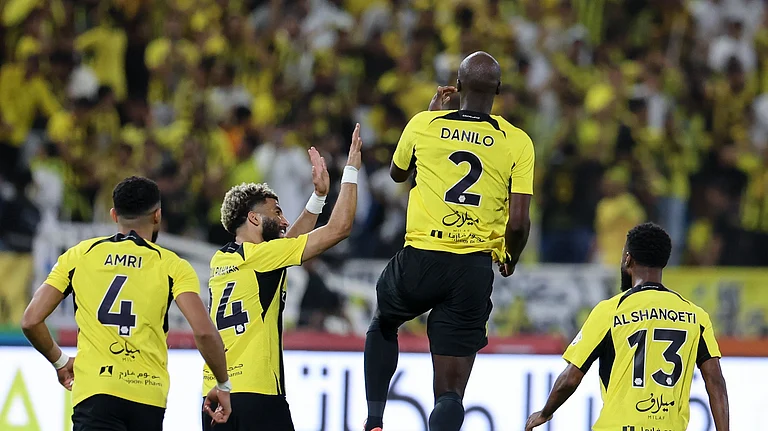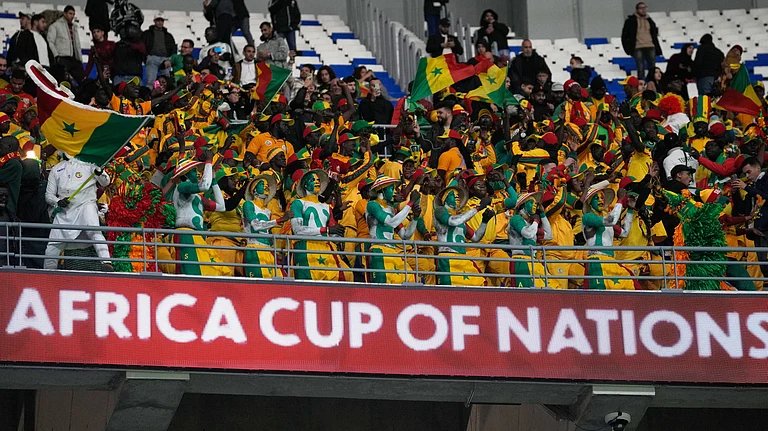Thank you, Mr President, Mr, President and Mr, Secretary General, distinguishedcolleagues.
I would like to begin by expressing my thanks for the special effort thateach of you made to be here today. This is an important day for us all as wereview the situation with respect to Iraq and its disarmament obligations underUN Security Council Resolution 1441.
Last November 8, this Council passed Resolution 1441 by a unanimous vote. Thepurpose of that resolution was to disarm Iraq of its weapons of massdestruction. Iraq had already been found guilty of material breach of itsobligations stretching back over 16 previous resolutions and 12 years.
Resolution 1441 was not dealing with an innocent party, but a regime thisCouncil has repeatedly convicted over the years.
Resolution 1441 gave Iraq one last chance, one last chance to come intocompliance or to face serious consequences. No Council member present and votingon that day had any illusions about the nature and intent of the resolution orwhat serious consequences meant if Iraq did not comply.
And to assist in its disarmament, we called on Iraq to cooperate withreturning inspectors from UNMOVIC and IAEA. We laid down tough standards forIraq to meet to allow the inspectors to do their job.
This Council placed the burden on Iraq to comply and disarm, and not on theinspectors to find that which Iraq has gone out of its way to conceal for solong. Inspectors are inspectors; they are not detectives.
I asked for this session today for two purposes. First, to support the coreassessments made by Dr. Blix and Dr. ElBaradei. As Dr. Blix reported to thisCouncil on January 27, "Iraq appears not to have come to a genuineacceptance, not even today, of the disarmament which was demanded of it."
And as Dr. ElBaradei reported, Iraq's declaration of December 7 "did notprovide any new information relevant to certain questions that have beenoutstanding since 1998."
My second purpose today is to provide you with additional information, toshare with you what the United States knows about Iraq's weapons of massdestruction, as well as Iraq's involvement in terrorism, which is also thesubject of Resolution 1441 and other earlier resolutions.
I might add at this point that we are providing all relevant information wecan to the inspection teams for them to do their work.
The material I will present to you comes from a variety of sources. Some areU.S. sources and some are those of other countries. Some are the sources aretechnical, such as intercepted telephone conversations and photos taken bysatellites. Other sources are people who have risked their lives to let theworld know what Saddam Hussein is really up to.
I cannot tell you everything that we know, but what I can share with you,when combined with what all of us have learned over the years, is deeplytroubling. What you will see is an accumulation of facts and disturbing patternsof behavior. The facts and Iraqis' behavior, Iraq's behavior, demonstrate thatSaddam Hussein and his regime have made no effort, no effort, to disarm, asrequired by the international community.
Indeed, the facts and Iraq's behavior show that Saddam Hussein and his regimeare concealing their efforts to produce more weapons of mass destruction.
Let me begin by playing a tape for you. What you’re about to hear is aconversation that my government monitored. It takes place on November 26 of lastyear, on the day before United Nations teams resumed inspections in Iraq. Theconversation involves two senior officers, a colonel and a brigadier generalfrom Iraq's elite military unit, the Republican Guard.
(The tape is played.)
Let me pause and review some of the key elements of this conversation thatyou just heard between these two officers.
First, they acknowledge that our colleague, Mohammed ElBaradei is coming, andthey know what he's coming for and they know he's coming the next day. He'scoming to look for things that are prohibited. He is expecting these gentlemento cooperate with him and not hide things.
But they're worried. We have this modified vehicle. What do we say if one ofthem sees it? What is their concern? Their concern is that it's something theyshould not have, something that should not be seen.
The general was incredulous: "You didn't get it modified. You don't haveone of those, do you?"
"I have one."
"Which? From where?"
"From the workshop. From the Al-Kindi Company."
"What?"
"From Al-Kindi."
"I'll come to see you in the morning. I'm worried you all have somethingleft."
"We evacuated everything. We don't have anything left."
Note what he says: "We evacuated everything." We didn't destroy it.We didn't line it up for inspection. We didn't turn it into the inspectors. Weevacuated it to make sure it was not around when the inspectors showed up."I will come to you tomorrow."
The Al-Kindi Company. This is a company that is well known to have beeninvolved in prohibited weapons systems activity.
Let me play another tape for you. As you will recall, the inspectors found 12empty chemical warheads on January 16th. On January 20, 4 days later, Iraqpromised the inspectors it would search for more. You will now hear an officerfrom Republican Guard headquarters issuing an instruction to an officer in thefield. Their conversation took place just last week, on January 30.
(The tape was played.)
Let me pause again and review the elements of this message.
"They are inspecting the ammunition you have, yes?"
"Yes. For the possibility there are forbidden ammo."
"For the possibility there is, by chance, forbidden ammo?"
"Yes.
"And we sent you a message yesterday to clean out all the areas, thescrap areas, the abandoned areas. Make sure there is nothing there. Remember thefirst message: evacuate it."
This is all part of a system of hiding things and moving things out of theway and making sure they have left nothing behind.
You go a little further into this message and you see the specificinstructions from headquarters: "After you have carried out what iscontained in this message, destroy the message because I don't want anyone tosee this message."
"Okay."
"Okay."
Why? Why? This message would have verified to the inspectors that they havebeen trying to turn over things. They were looking for things, but they don'twant that message seen because they were trying to clean up the area, to leaveno evidence behind of the presence of weapons of mass destruction. And they canclaim that nothing was there and the inspectors can look all they want and theywill find nothing.
This effort to hide things from the inspectors is not one or two isolatedevents. Quite the contrary, this is part and parcel of a policy of evasion anddeception that goes back 12 years, a policy set at the highest levels of theIraqi regime.
We know that Saddam Hussein has what is called "a Higher Committee forMonitoring the Inspection Teams." Think about that. Iraq has a high-levelcommittee to monitor the inspectors who were sent in to monitor Iraq'sdisarmament -- not to cooperate with them, not to assist them, but to spy onthem and keep them from doing their jobs.
The committee reports directly to Saddam Hussein. It is headed by Iraq's VicePresident, Taha Yasin Ramadan. Its members include Saddam Hussein's son, Kusay.
This committee also includes Lieutenant General Amir al-Sadi, an advisor toSaddam. In case that name isn't immediately familiar to you, General Sadi hasbeen the Iraqi regime's primary point of contact for Dr. Blix and Dr. ElBaradei.It was General Sadi who last fall publicly pledged that Iraq was prepared tocooperate unconditionally with inspectors. Quite the contrary, Sadi's job is notto cooperate; it is to deceive, not to disarm, but to undermine the inspectors;not to support them, but to frustrate them and to make sure they learn nothing.
We have learned a lot about the work of this special committee. We learnedthat just prior to the return of inspectors last November, the regime haddecided to resume what we heard called "the old game ofcat-and-mouse."
For example, let me focus on the now famous declaration that Iraq submittedto this Council on December 7. Iraq never had any intention of complying withthis Council's mandate. Instead, Iraq planned to use the declaration tooverwhelm us and to overwhelm the inspectors with useless information aboutIraq's permitted weapons so that we would not have time to pursue Iraq'sprohibited weapons. Iraq's goal was to give us in this room, to give those of uson this Council, the false impression that the inspection process was working.
You saw the result. Dr. Blix pronounced the 12,200-page declaration rich involume but poor in information and practically devoid of new evidence. Could anymember of this Council honestly rise in defense of this false declaration?
Everything we have seen and heard indicates that instead of cooperatingactively with the inspectors to ensure the success of their mission, SaddamHussein and his regime are busy doing all they possibly can to ensure thatinspectors succeed in finding absolutely nothing.
My colleagues, every statement I make today is backed up by sources, solidsources. These are not assertions. What we are giving you are facts andconclusions based on solid intelligence. I will cite some examples, and theseare from human sources.
Orders were issued to Iraq's security organizations, as well as to SaddamHussein's own office, to hide all correspondence with the Organization ofMilitary Industrialization. This is the organization that oversees Iraq'sweapons of mass destruction activities. Make sure there are no documents leftwhich would connect you to the OMI.
We know that Saddam's son, Kusay, ordered the removal of all prohibitedweapons from Saddam's numerous palace complexes. We know that Iraqi governmentofficials, members of the ruling Baath Party and scientists have hiddenprohibited items in their homes. Other key files from military and scientificestablishments have been placed in cars that are being driven around thecountryside by Iraqi intelligence agents to avoid detection.
Thanks to intelligence they were provided, the inspectors recently founddramatic confirmation of these reports. When they searched the homes of an Iraqinuclear scientist, they uncovered roughly 2,000 pages of documents. You see themhere being brought out of the home and placed in UN hands. Some of the materialis classified and related to Iraq's nuclear program.
Tell me, answer me: Are the inspectors to search the house of everygovernment official, every Baath Party member and every scientist in the countryto find the truth, to get the information they need, to satisfy the demands ofour Council?
Our sources tell us that in some cases the hard drives of computers at Iraqiweapons facilities were replaced. Who took the hard drives? Where did they go?What is being hidden? Why?
There is only one answer to the why: to deceive, to hide, to keep from theinspectors.
Numerous human sources tell us that the Iraqis are moving not just documentsand hard drives, but weapons of mass destruction, to keep them from being foundby inspectors. While we were here in this Council chamber debating Resolution1441 last fall, we know, we know from sources that a missile brigade outsideBaghdad was dispersing rocket launchers and warheads containing biologicalwarfare agent to various locations, distributing them to various locations inwestern Iraq.
Most of the launchers and warheads had been hidden in large groves of palmtrees and were to be moved every one to four weeks to escape detection.
We also have satellite photos that indicate that banned materials haverecently been moved from a number of Iraqi weapons of mass destructionfacilities.
Let me say a word about satellite images before I show a couple. The photosthat I am about to show you are sometimes hard for the average person tointerpret, hard for me. The painstaking work of photo analysis takes expertswith years and years of experience, pouring for hours and hours over lighttables. But as I show you these images, I will try to capture and explain whatthey mean, what they indicate, to our imagery specialists.
Let's look at one. This one is about a weapons munition facility, a facilitythat holds ammunition at a place called Taji. This is one of about 65 suchfacilities in Iraq. We know that this one has housed chemical munitions. Infact, this is where the Iraqis recently came up with the additional fourchemical weapons shells.
Here you see 15 munitions bunkers in yellow and red outlines. The four that arein red squares represent active chemical munitions bunkers.
How do I know that? How can I say that? Let me give you a closer look. Lookat the image on the left. On the left is a close-up of one of the four chemicalbunkers. The two arrows indicate the presence of sure signs that the bunkers arestoring chemical munitions. The arrow at the top that says "security"points to a facility that is a signature item for this kind of bunker. Insidethat facility are special guards and special equipment to monitor any leakagethat might come out of the bunker. The truck you also see is a signature item.It's a decontamination vehicle in case something goes wrong. This ischaracteristic of those four bunkers. The special security facility and thedecontamination vehicle will be in the area, if not at any one of them or one ofthe other, it is moving around those four and it moves as needed to move aspeople are working in the different bunkers.
Now look at the picture on the right. You are now looking at two of thosesanitized bunkers. The signature vehicles are gone, the tents are gone. It'sbeen cleaned up. And it was done on the 22nd of December as the UN inspectionteam is arriving, and you can see the inspection vehicles arriving in the lowerportion of the picture on the right.
The bunkers are clean when the inspectors get there. They found nothing.
This sequence of events raises the worrisome suspicion that Iraq had beentipped off to the forthcoming inspections at Taji. As it did throughout the1990s, we know that Iraq today is actively using its considerable intelligencecapabilities to hide its illicit activities. From our sources, we know thatinspectors are under constant surveillance by an army of Iraqi intelligenceoperatives. Iraq is relentlessly attempting to tap all of their communications,both voice and electronics. I would call my colleagues' attention to the finepaper that the United Kingdom distributed yesterday which describes in exquisitedetail Iraqi deception activities.
In this next example, you will see the type of concealment activity Iraq hasundertaken in response to the resumption of inspections. Indeed, in November of2002, just when the inspections were about to resume, this type of activityspiked. Here are three examples.
At this ballistic missile site on November 10, we saw a cargo truck preparingto move ballistic missile components.
At this biological weapons-related facility on November 25, just 2 daysbefore inspections resumed, this truck caravan appeared -- something we almostnever see at this facility and we monitor it carefully and regularly.
At this ballistic missile facility, again, 2 days before inspections began,five large cargo trucks appeared, along with a truck-mounted crane, to movemissiles.
We saw this kind of housecleaning at close to 30 sites. Days after thisactivity, the vehicles and the equipment that I've just highlighted disappearand the site returns to patterns of normalcy. We don't know precisely what Iraqwas moving, but the inspectors already knew about these sites so Iraq knew thatthey would be coming.
We must ask ourselves: Why would Iraq suddenly move equipment of this naturebefore inspections if they were anxious to demonstrate what they had or did nothave?
Remember the first intercept in which two Iraqis talked about the need tohide a modified vehicle from the inspectors. Where did Iraq take all of thisequipment? Why wasn't it presented to the inspectors?
Iraq also has refused to permit any U-2 reconnaissance flights that wouldgive the inspectors a better sense of what's being moved before, during andafter inspectors. This refusal to allow this kind of reconnaissance is indirect, specific violation of operative paragraph seven of our Resolution 1441.
Saddam Hussein and his regime are not just trying to conceal weapons; theyare also trying to hide people. You know the basic facts. Iraq has not compliedwith its obligation to allow immediate, unimpeded, unrestricted and privateaccess to all officials and other persons, as required by Resolution 1441. Theregime only allows interviews with inspectors in the presence of an Iraqiofficial, a minder. The official Iraqi organization charged with facilitatinginspections announced publicly and announced ominously, that, "Nobody isready to leave Iraq to be interviewed."
Iraqi Vice President Ramadan accused the inspectors of conducting espionage,a veiled threat that anyone cooperating with UN inspectors was committingtreason.
Iraq did not meet its obligations under 1441 to provide a comprehensive listof scientists associated with its weapons of mass destruction programs. Iraq'slist was out of date and contained only about 500 names despite the fact thatUNSCOM had earlier put together a list of about 3,500 names.





















